USS Valley Forge
(From the Diary of Warren R. Smith)
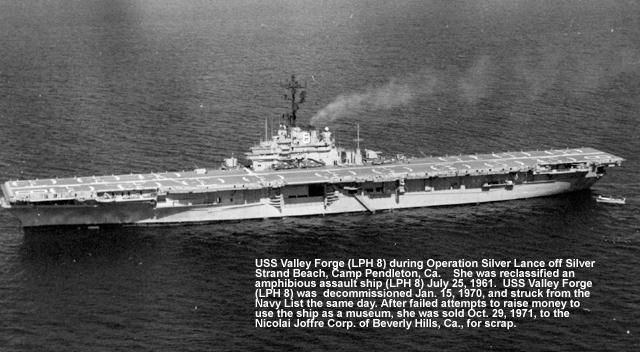
(To enlarge images, click on highlighted narrative)

(To enlarge images, click on highlighted narrative)
The squadron returned to Okinawa about the middle of June. We had a month to rest and get ourselves put back together before our next adventure, the USS Valley Forge. Our standard procedure for going aboard ship in the past was to land on the flight deck as it was steaming in open waters. This time the ship came to us and we climbed the gangplank at Naha. I believe a decision was made to only ruin one compliment of planes with the corrosive effects of sea water.
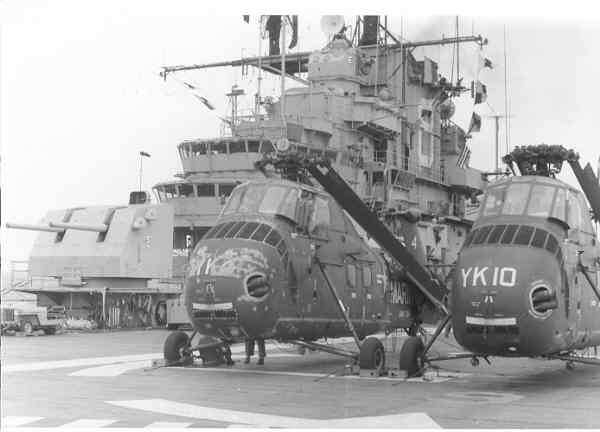 The
UH-34D was made from magnesium to give it more lift, as it was lighter
weighing 2/3rd that of aluminum. A problem magnesium has with shipboard
life is that it is derived from saltwater. It always wants to go
back to its original form when it comes in contact with this medium again.
Once at sea, the planes start corroding immediately and require constant
attention to keep them from turning into white powder and blowing away.
There were three Marine squadrons in the Orient during our tour, one on
ship, one in Vietnam, and one in Okinawa. During our tour, the planes
stayed put and the squadron personnel moved to the different locations.
The new planes we brought with us to Okinawa stayed there and we got to
use them for a short time on 3 different occasions. One thing our
squadron had learned, during the 9 months of carrier duty during the atomic
tests, was that waxing the planes really helped to slow the corrosion.
The toughest spots were always under rivet head. You couldn't get
the wax under there and it was a good hiding place for the moisture.
The standard procedure in fighting corrosion was first to scrap the metal
clean to bright metal. You would dab it with acid to eat out any
remaining traces of corrosion followed by neutralizing this acid.
To cover this bare area, first a coat of zinc chromate was applied to give
the finish paint a bonding surface. The zinc
chromate was chartreuse in color and was a real clash with the olive
drab final coat the Marine Corps like to see covering their equipment.
The
UH-34D was made from magnesium to give it more lift, as it was lighter
weighing 2/3rd that of aluminum. A problem magnesium has with shipboard
life is that it is derived from saltwater. It always wants to go
back to its original form when it comes in contact with this medium again.
Once at sea, the planes start corroding immediately and require constant
attention to keep them from turning into white powder and blowing away.
There were three Marine squadrons in the Orient during our tour, one on
ship, one in Vietnam, and one in Okinawa. During our tour, the planes
stayed put and the squadron personnel moved to the different locations.
The new planes we brought with us to Okinawa stayed there and we got to
use them for a short time on 3 different occasions. One thing our
squadron had learned, during the 9 months of carrier duty during the atomic
tests, was that waxing the planes really helped to slow the corrosion.
The toughest spots were always under rivet head. You couldn't get
the wax under there and it was a good hiding place for the moisture.
The standard procedure in fighting corrosion was first to scrap the metal
clean to bright metal. You would dab it with acid to eat out any
remaining traces of corrosion followed by neutralizing this acid.
To cover this bare area, first a coat of zinc chromate was applied to give
the finish paint a bonding surface. The zinc
chromate was chartreuse in color and was a real clash with the olive
drab final coat the Marine Corps like to see covering their equipment.
Starting out from Okinawa, we didn't know how extensive this corrosion battle was going to become, we were excited about all the exotic places and fun that were horizons ahead of us. This cruise was to take us to Taiwan, Philippines, Malaysia, Australia, New Zealand, and possibly Hong Kong on the way back to Okinawa. We had met a number of sailors from the New Zealand navy when we were in Hawaii during the atomic tests and they had wet our appetites. They told us that most all the men had to serve in the navy from 18 – 26 leaving women of that age pretty lonely. W.W.II had endeared this island country to Marines and they were still held in high regard. We were even told their mothers would welcome us with open arms. We were on our way to Marine Corps heaven.
We left the port of Naha, Okinawa on July 24th and for the next couple of days worked to carrier qualify our pilots. Most all of us had prior carrier duty, so we fell right back into the routine. The landing sites in Vietnam were pretty small and hazardous, but at least they weren't moving, rocking and pitching all at the same time. Our flight gear has traded, the flak vest for a “Mae West”. Both are designed to save your life, but for different reasons. We eased into this new flight pattern with daylight training and by the 27th we were at Koahsiung, Taiwan.
Koahsiung is an industrial city that sits at the southern tip of this Chinese National island fortress. It is an industrial city, but the harbor will not take a ship of our size requiring us to anchor in deeper waters. The anchoring was not bad, but made it tough for a night on the town. The days of not worrying about your attire while in Vietnam gives way to inspections of the uniform of the day. Everything had to be squared away to get off the ship. Shined and creased we went down the ladder to a waiting landing craft, our taxi to shore. The squared away look was soon washed away as the spray from waves hitting the square front ramp rained down on us. It almost felt good as it was stinking hot and humid along with being shoulder to shoulder all the way in. So much for being squared away just to get on the landing craft, we looked like we swam from the ship by the time we hit shore.
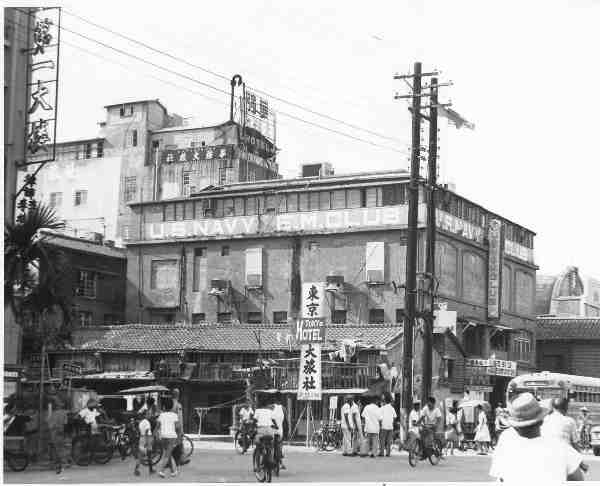 Once
on shore, we wondered why we had expended the effort. At one end
of the street was the dock and the other end was the EM
Club. All areas outside of that main drag were not authorized
and patrolled by the MPs. It was like liberty on a large bowling
alley with hardly a spot from one end to the other that didn't contain
a bar trying to get you inside. All I can remember was how humid
and hot it was and how good the cool beer tasted. The weather was
ready made for all these bars. You tried to keep your military bearing
with your uniform and then just gave up, you were soaking wet with sweat
all the time. At least we didn't have to wear the tropical worsted
with a tie; we were all cotton with short sleeves and open collar.
The barracks hat was not easily stored on ship and was thankfully substituted
with the fore and aft “piss cutter”. It was so hot the polish just
ran off your shoes and soaked into the edges of the sole. By midnight,
the dock was covered with fallen down Marines and the ones standing were
relieving themselves of all that beer. The waves woke up the fallen
down that were loaded on board and their stomachs didn't like the rolling
trip back. You tried to find a corner out of the way of sick and
disorderly. The next day I went in to just take pictures for the
cruise book and came back in the early evening, a good lesson learned.
All I can say about Taiwan is we stopped in for a beer and the women were
very good looking.
Once
on shore, we wondered why we had expended the effort. At one end
of the street was the dock and the other end was the EM
Club. All areas outside of that main drag were not authorized
and patrolled by the MPs. It was like liberty on a large bowling
alley with hardly a spot from one end to the other that didn't contain
a bar trying to get you inside. All I can remember was how humid
and hot it was and how good the cool beer tasted. The weather was
ready made for all these bars. You tried to keep your military bearing
with your uniform and then just gave up, you were soaking wet with sweat
all the time. At least we didn't have to wear the tropical worsted
with a tie; we were all cotton with short sleeves and open collar.
The barracks hat was not easily stored on ship and was thankfully substituted
with the fore and aft “piss cutter”. It was so hot the polish just
ran off your shoes and soaked into the edges of the sole. By midnight,
the dock was covered with fallen down Marines and the ones standing were
relieving themselves of all that beer. The waves woke up the fallen
down that were loaded on board and their stomachs didn't like the rolling
trip back. You tried to find a corner out of the way of sick and
disorderly. The next day I went in to just take pictures for the
cruise book and came back in the early evening, a good lesson learned.
All I can say about Taiwan is we stopped in for a beer and the women were
very good looking.
July 30th.
We set sail for the Philippines and spent the 31st
with more carrier qualifications. As in Vietnam, getting into the
air is a relief from the heat. The temperature at 2,000 ft. is just
about right and the slipstream blowing in at lower altitudes makes it comfortable.
Riding the air is always better than riding the waves. It has only
been a few days and we are ready to feel solid land under our feet.
We arrived in the Philippines on August 1st and were docked at Subic Bay
by 1400 hours. We flew a number of the planes to Cubic Point and
part of the squadron went ashore to live in barracks. Some of us
have real beds with mattresses and you don't hit your head on a bulkhead
when going to the mess hall. There isn't room for all the squadron,
but the plan is to rotate everyone so we will have this break in living
accommodations. This major 7th fleet naval base had all that was needed
to keep us happy. There were a number of clubs, PX, movie theater,
bowling alley, dairy, grill, and the land was lush with trees and flower
beds. The heat had followed us to the Philippines and you could understand
why Filipinos wore those large loose fitting shirts. We found out
it was so lush because it seemed to rain every 15 minutes. It was
a pretty nice place if you discounted Olongapo located just outside the
main gate. Olongapo has to be one of the nastiest towns of the Orient.
August 4th.
It was back to work as we pulled out of port to work
on night carrier qualifications. We would put to test the skills
polished on the way down from Okinawa. Nighttime carrier operations
push everyone to a higher plateau. The ship is darkened including
the ready room and corridors leading to the flight deck. Great concern
is taken not to wreck the night vision of the pilots. It takes a
high degree of skill, concentration, and a great trust in those directing
you down with a couple of lighted wanes. This is especially true
if you are trying to slide in between the buzz saw of a tail rotor in front
of the cockpit window and a set of 5” guns on your tail as you are cozy
your main landing gear up close to a dark catwalk running 60 feet above
the sea. The operation is complicated by this activity being duplicated
at various landing spots along the flight deck. As soon as a plane
is shut down, it is moved to the rear to make the spot available for another
plane. The darkness makes everyone's job a little more hazardous.
We have good pilots, tested by enemy fire. Those of us that ride
in the belly don't carry much fear with us; we know our planes and trust
our pilots. They have already flown us through some pretty tough
sky getting us to this point. We are schedule for 3 days of night
qualifications.
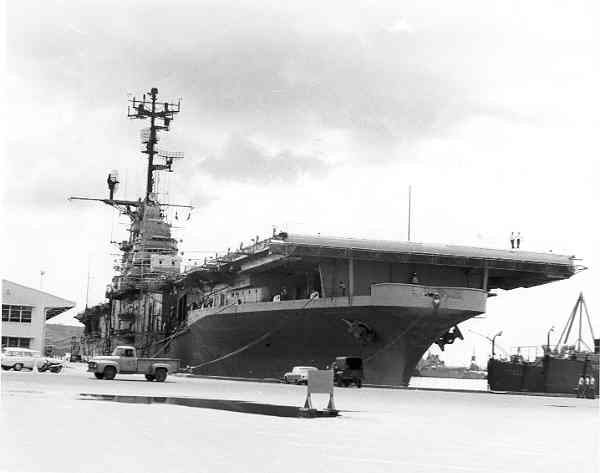 I
don't know what time it was, but I definitely felt the ship hit something.
I got dressed and went topside to see what was going on. To my amazement,
we are back in Subic Bay and docking.
It is very early this August 5th morning, but there is already a flurry
of activity everywhere. The harbor is full of ships from Special Landing
Force 76 and Marine “grunts” are everywhere with their equipment.
We start loading them aboard along with all our equipment and people that
were staying at the barracks. We are on 4 hour alert because of a
crisis that has developed in Vietnam. We are to learn later that
North Vietnamese PT boats had attacked a couple of our destroyers.
It was referred from that point on as the Bay of Tonkin Incident.
As troops and equipment are being loaded, the ship is taking on as much
fuel as it will hold. We leave port that afternoon at 1800 hours
with some APAs, LSDs and subs. The port is emptied and we are all
headed due west as fast as the task force can steam.
I
don't know what time it was, but I definitely felt the ship hit something.
I got dressed and went topside to see what was going on. To my amazement,
we are back in Subic Bay and docking.
It is very early this August 5th morning, but there is already a flurry
of activity everywhere. The harbor is full of ships from Special Landing
Force 76 and Marine “grunts” are everywhere with their equipment.
We start loading them aboard along with all our equipment and people that
were staying at the barracks. We are on 4 hour alert because of a
crisis that has developed in Vietnam. We are to learn later that
North Vietnamese PT boats had attacked a couple of our destroyers.
It was referred from that point on as the Bay of Tonkin Incident.
As troops and equipment are being loaded, the ship is taking on as much
fuel as it will hold. We leave port that afternoon at 1800 hours
with some APAs, LSDs and subs. The port is emptied and we are all
headed due west as fast as the task force can steam.
August 6th.
We are still headed west with calm seas. The
situation is getting more serious as the ship sends up 100 rounds for each
gun mount, more watches are set, and we are running with darken ship.
August 7th.
The corpsman take battle dressing to all aid stations.
We can no longer dump trash and garbage at will over the side at will.
The whole force will dump at the same time and garbage will be ground up
and discharged in front of the props. The theory is that when a task
force dumps trash randomly, it sends a long trail behind which can be tracked
by the enemy. I thought the Russian subs would use a little more
sophistication.
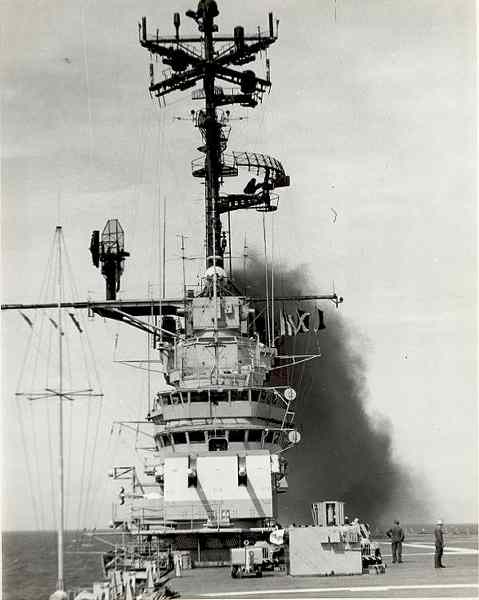 These
new rules help us understand why we were billeted in our current location.
We are next to the garbage grinding equipment room and all the ship's garbage
is piled next to the compartment till it is time to grind. The Navy
doesn't love us as much as those wonderful ladies we were to meet in New
Zealand and Australia. We eat with our nose day and night.
With our next-door neighbor, a lot of sweaty bodies (it never got below
90 degrees in the compartment), and crowded space, many of the flight crews
lived in the planes day and night. With a door open and windows removed
in the cabin and cockpit sections you had a good breeze. It seemed
when you were wide open like this, with a nice breeze blowing through the
plane, is when the Navy would conduct a procedure known as "blowing
the stacks" which cleaned the accumulated oil and soot from the boiler
up through the smoke stack. This process rolled a thick cloud of
sticky black smoke through the plane and over all the inhabitants.
Brushing your teeth in the morning doesn't quite get rid of all the sulfur
taste. The troop seats gave you about the same room as the rack in
the ships squadron compartment.
These
new rules help us understand why we were billeted in our current location.
We are next to the garbage grinding equipment room and all the ship's garbage
is piled next to the compartment till it is time to grind. The Navy
doesn't love us as much as those wonderful ladies we were to meet in New
Zealand and Australia. We eat with our nose day and night.
With our next-door neighbor, a lot of sweaty bodies (it never got below
90 degrees in the compartment), and crowded space, many of the flight crews
lived in the planes day and night. With a door open and windows removed
in the cabin and cockpit sections you had a good breeze. It seemed
when you were wide open like this, with a nice breeze blowing through the
plane, is when the Navy would conduct a procedure known as "blowing
the stacks" which cleaned the accumulated oil and soot from the boiler
up through the smoke stack. This process rolled a thick cloud of
sticky black smoke through the plane and over all the inhabitants.
Brushing your teeth in the morning doesn't quite get rid of all the sulfur
taste. The troop seats gave you about the same room as the rack in
the ships squadron compartment.
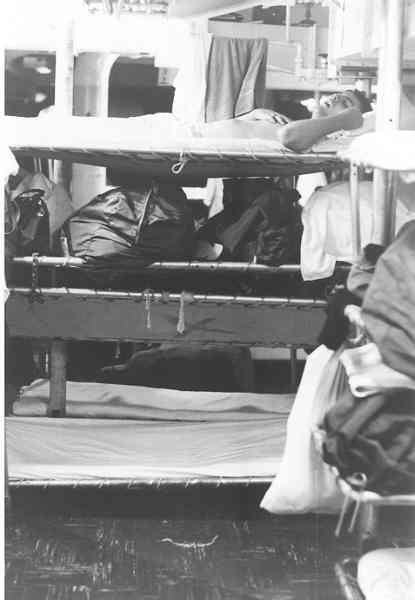 When
you come aboard you are given a canvas with ringlets every 6” and a length
of rope. In the compartment are numerous aluminum rectangles made
from tubing. They fold down from each side of 2 steel posts and there
is about 18” height between them. You take the canvas and lash it
to the aluminum tubing with the rope and this becomes
your home till you leave. You learn that the tighter the canvas,
the more comfortable it is. You are constantly tightening it like
a drumhead. During the day, this bare bones bed becomes a storage
area for your sea bag and other possessions. There is no need for sheets
or blankets because of the temperature.
When
you come aboard you are given a canvas with ringlets every 6” and a length
of rope. In the compartment are numerous aluminum rectangles made
from tubing. They fold down from each side of 2 steel posts and there
is about 18” height between them. You take the canvas and lash it
to the aluminum tubing with the rope and this becomes
your home till you leave. You learn that the tighter the canvas,
the more comfortable it is. You are constantly tightening it like
a drumhead. During the day, this bare bones bed becomes a storage
area for your sea bag and other possessions. There is no need for sheets
or blankets because of the temperature.
The Valley Forge was built for W.W.II and ventilation
was via air ducts without air conditioning. Our sheet metal guys
came up with a valuable modification to make the compartment more bearable.
They made some flat scoops that could be inserted in the ducts coming through
our compartment by just removing a few bolts in the bottom of the duct.
It would block a lot of the flow and redirect it into our compartment.
These air bandits would be removed in the morning when the ship's heating
and ventilating guys were trying to figure out why the
sailors downstream were complaining. We are
located below and beside the aft center elevator. If you leave the
access door open, the compartment gets a great blast of air every time
the elevator drops. Stale air is sucked out on its return trip to
the flight deck. Marines are taught to make use of the environment
around them.
The metal shop was also making gun mounts they had perfected at Da Nang for all the aircraft. The flight crews drew flack vests, pistols and rifles in the afternoon. We are now 80 miles off the coast and awaiting word to land troops. The grunts have been issued ammo, which they are busy cleaning along with a lot of bayonet sharpening. They are getting ready to charge the flame-throwers. It looks like we are back to the shooting war again. Our prior experience makes us calmer than the “grunts”, they are really charged up and have a grim look about them. My plane is still waiting for parts and hasn't flown since coming aboard. If we launch, I may fly as a back up with another crew. I hope that doesn't happen, as it would mean that they had been killed or wounded. There is the possibility of landing the “grunts” as a show of force but there is concern they are so charged up they might shoot some innocent people and create a larger mess than we already have. Washington is working late and feel they know best from where they sit.
August 8th.
We have two choppers from HMM-162 fly in from Da Nang
with some “brass” and some parts we needed. We rip out all the seats
from the planes and install gun mounts. The carrier meets up with a tanker
and takes on fuel.
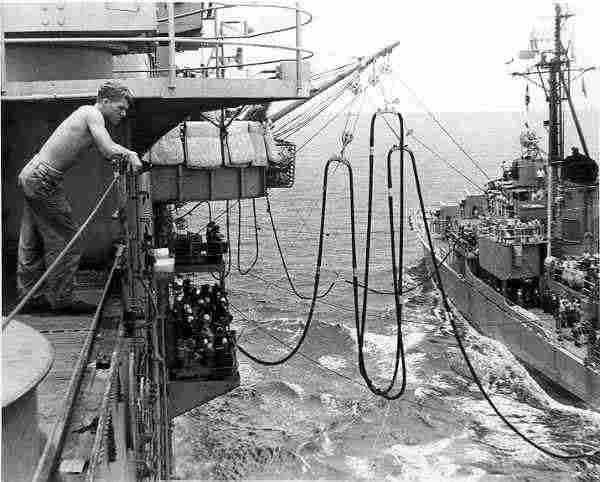 Generally
they dump a whole tanker into the carrier and
then the carrier supplies all the destroyers and support ships around us.
It allows the tanker to get back for another load quicker. The refueling
can take all night of steaming next to one another connected from side
to side with large black hoses. To start the process a sailor with
a shotgun shoots a projectile connected to a light line to the carrier.
This in turn is connected to lines of increasing size. At the end
of the process there is a heavy pulley system between the 2 ships, which
can be used to transfer hoses, cargo and even personnel. When
the tanker pulls up to us it is very low in the water and the next morning
they have grown out of the water. The fuel is good ballast for us
and replaces the sea water that displaces the fuel as it is used removing
the explosive atmosphere. This constant displacement of fuel with
sea water makes it doubly important to sample fuel before it is pumped
into the planes. We had an incident where sea water was actually
pumped into a plane requiring the total disassembly of the fuel system.
It was caught as part of the preflight sampling of the plane's fuel.
Trying to fly over sea water with sea water for fuel is asking to become
a fish. We like to see any ship pull up as it might have some mail
for the squadron.
Generally
they dump a whole tanker into the carrier and
then the carrier supplies all the destroyers and support ships around us.
It allows the tanker to get back for another load quicker. The refueling
can take all night of steaming next to one another connected from side
to side with large black hoses. To start the process a sailor with
a shotgun shoots a projectile connected to a light line to the carrier.
This in turn is connected to lines of increasing size. At the end
of the process there is a heavy pulley system between the 2 ships, which
can be used to transfer hoses, cargo and even personnel. When
the tanker pulls up to us it is very low in the water and the next morning
they have grown out of the water. The fuel is good ballast for us
and replaces the sea water that displaces the fuel as it is used removing
the explosive atmosphere. This constant displacement of fuel with
sea water makes it doubly important to sample fuel before it is pumped
into the planes. We had an incident where sea water was actually
pumped into a plane requiring the total disassembly of the fuel system.
It was caught as part of the preflight sampling of the plane's fuel.
Trying to fly over sea water with sea water for fuel is asking to become
a fish. We like to see any ship pull up as it might have some mail
for the squadron.
The mail is the lifeblood of morale. No incoming mail today, but they took our letters and got them started toward home. Writing letters in the service is like planting seeds. The more you write, the more you receive. It is something to look forward to and a root to home. You need to watch for guys that aren't getting mail and find out what the problem is. They can get pretty deep in the dumps and you need to be vigilant on the flight deck.
August 9th.
We finished installing the gun mounts and had 4 planes
take off at 0600 returning at 1300. They must have gone to Da Nang.
The task force is increasing. We joined up with 2 attack carriers
and 8 destroyers in the afternoon and picked up our APAs, LSDs, and oiler
in the evening.
The daily routine was shaken up with a sounding of general quarters. The difference with this one from the many we had listened to in the past was this was for real. It was mentioned a number of times that “this is not a drill, I repeat, this is not a drill”. I have never seen the sailors move so fast to their stations. Drills are typed on the “orders of the day” and most of the time the sailors are already at their stations before a drill is sounded. I seem to remember that you go forward and up on the starboard side and aft and down on the port side. Trying to do otherwise in one of these drills is impossible with everyone on ship moving at the same time in great haste. You learn to go down ladders (the naval term for stairs aboard ship) by grabbing the handrails and sliding with the control of your grip to the bottom. Running down the corridors can be hazardous if you get out of the rhythm of ducking your head as you jump through the bulkhead doors. If you miss, it could knock you cold or bust your shin. You have to get to your battle stations fast because the sailors start closing these bulkhead doors to seal sections of the ship from each other in case of a breach in battle. This allows only one section of the ship to fill with water, smoke or fire and the rest of the ship is saved. The “grunts” are generally held in their compartments below deck and it can be miserable. All ventilation is shut down to keep smoke and toxic fume transfer to a minimum. The flight crews are generally on the flight deck in their planes with plenty of fresh air. In this particular case, a reconnaissance plane had spotted a couple of PT boats traveling at high speed from the north toward us. It was thought they might be North Vietnamese making a run at the fleet. They were later identified as PT boats, but belonging to the South Vietnamese Navy. It was nice to see our destroyers take position between them and us.
August 10th.
We sailed all day without a destination and had night
flying. It was a scary evening as the rudder on the carrier stuck
in full starboard and we about ran over one of our escorting destroyers.
August 11th.
We sailed the coast again today with the task force
around us. We get air cover from the fleet and today we watched as
some A-1, Skyraiders practiced strafing our ship wake. It was a little
scary not knowing what they were doing as they started their dive on us.
We are glad the enemy doesn't have aircraft in the area.
August 12th.
We had 12 planes go into Da Nang today and this allowed
us to get some mail out. 700 lbs. of mail was brought back, but none
was for the squadron. We are a delivery service for the fleet.
At least we can go get the mail if it is close. We have a special
attachment to the destroyers as they are rescue agents for downed aircraft
and can keep the PT boats and subs at bay if needed.
August 13th.
We now have 12 other ships with us, APAs, AKAs, LSDs,
oilers, and destroyers. We took on more oil and gas today and it
was announced there might be an enemy sub in the area. That would
most likely be a Russian.
August 14 – 25th.
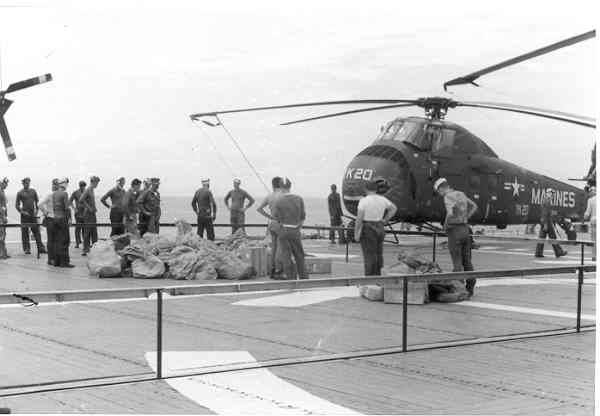 The
days are all running together with monotony. We have had only 2 mail
calls since leaving Subic and the task force is up to about 20-22 ships.
We play a delivery roll for everything. One morning, way before sunrise,
the watch wakes me for a special mission. My thought go back to another
early morning “special mission” that was a long day waiting to fly into
Laos for a downed pilot. I get my 1st mechanic, Larry Henderson and
we go to the flight deck to spread the blade and preflight the bird.
Soon the pilots are there and we are waiting for cargo. The cargo
is carried to us by sailors and consists of large cardboard boxes.
It is pretty apparent once loaded that this is a “cream puff” mission.
The plane is filled with the smell of fresh baked donuts and we are going
to make breakfast special for our destroyer escorts. It does prove
to be somewhat of a dangerous mission, as we have to hover in the early
light over the stern of the boat as it pitches around in the sea as I lower
the donuts down with the hoist. There are appreciative sailors below
to catch the cargo and let us back off as soon as possible. While
hovering, we are dangerously close to the antennas and communication cables
of the destroyer.
The
days are all running together with monotony. We have had only 2 mail
calls since leaving Subic and the task force is up to about 20-22 ships.
We play a delivery roll for everything. One morning, way before sunrise,
the watch wakes me for a special mission. My thought go back to another
early morning “special mission” that was a long day waiting to fly into
Laos for a downed pilot. I get my 1st mechanic, Larry Henderson and
we go to the flight deck to spread the blade and preflight the bird.
Soon the pilots are there and we are waiting for cargo. The cargo
is carried to us by sailors and consists of large cardboard boxes.
It is pretty apparent once loaded that this is a “cream puff” mission.
The plane is filled with the smell of fresh baked donuts and we are going
to make breakfast special for our destroyer escorts. It does prove
to be somewhat of a dangerous mission, as we have to hover in the early
light over the stern of the boat as it pitches around in the sea as I lower
the donuts down with the hoist. There are appreciative sailors below
to catch the cargo and let us back off as soon as possible. While
hovering, we are dangerously close to the antennas and communication cables
of the destroyer.
I had another similar mission of service to the destroyers and this time it was on Sunday morning. The smaller destroyers didn't have chaplains on board and we had to take the chaplain from the carrier to them. This was a delivery and a pick up and the human cargo left less chance for error. I thought losing a man of god would definitely be bad luck. We had more light with the chaplain, which helped the pilots, but it took a lot of coordination between the pilot and crew chief to get him on that small drop zone. I always remember the look of fear on the face of the chaplain and his faith was tested as we pushed him out into the air. He would be sitting on the edge of the door clutching his equipment and I would raise the hoist, give him a push and then hit the down switch so he would clear the plane. It all got down to timing from here on. He would be swinging back and forth across the stern of the destroyer and I would lower as he came across each time till until a couple of big sailors could essentially tackle him. I think he prayed all the way down. Only once did I give him a small baptism. I got him a little low as we swung over a wave and we dragged some salt water. We would give them plenty of cable when picking up and the sailors would hold him till I got the slack out and when I saw the boat roll toward center I would hit the up switch and pull him straight off the deck.
We have been told what crew members have qualified for Combat Air Crew Wings. I found a place in the Leatherneck Magazine that sells them and have taken orders from all those that want them before we get back to Okinawa. Everyone thinks they will really look nice on the uniform and set us apart when we get stateside.
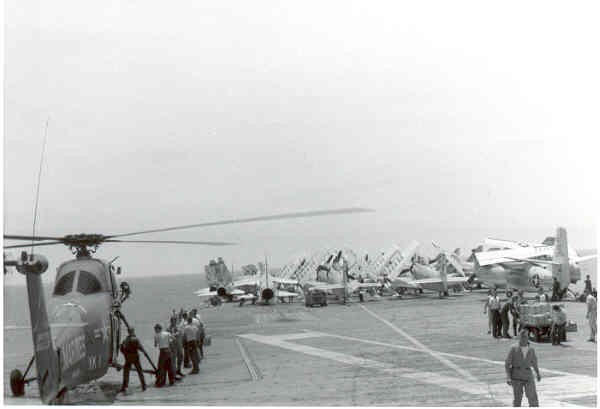 We
flew to the USS Kitty Hawk for parts and mail
as they had the ability of aircraft range. They could send planes
to Cubic, Saigon, or Da Nang, no matter our location. They had a
small jeep on the flight deck for transportation as the deck covered 4
½ acres. We now know how the destroyers feel when next to
the Valley Forge. We are an oddity on their flight deck with our
Marine choppers accented with zinc-chromate, but also seem to have their
respect as the word gets passed we are combat tested.
We
flew to the USS Kitty Hawk for parts and mail
as they had the ability of aircraft range. They could send planes
to Cubic, Saigon, or Da Nang, no matter our location. They had a
small jeep on the flight deck for transportation as the deck covered 4
½ acres. We now know how the destroyers feel when next to
the Valley Forge. We are an oddity on their flight deck with our
Marine choppers accented with zinc-chromate, but also seem to have their
respect as the word gets passed we are combat tested.
August 26th.
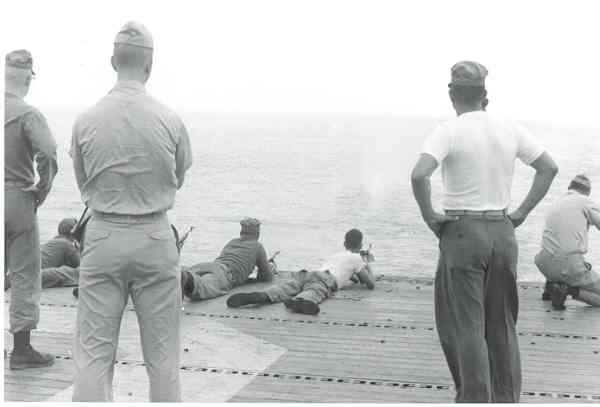 The
President of Vietnam has been overthrown and the whole task force is steaming
at top speed for Saigon. Everyone had to test
fire their weapons off the rear of the flight deck. The lazy days are
getting tense and serious again.
The
President of Vietnam has been overthrown and the whole task force is steaming
at top speed for Saigon. Everyone had to test
fire their weapons off the rear of the flight deck. The lazy days are
getting tense and serious again.
August 27th.
The conditions are worse in Saigon and all over Vietnam.
We strip all the planes of extra gear and bring all aircraft to the flight
deck. We are on 2 hr. stand by to launch. The crew chiefs are
briefed on landing in Saigon if needed to evacuate. We fight corrosion
while we wait.
August 28, 29th.
We are still on stand by for Saigon. The days
and nights are long as we wait for the excitement of an assault and evacuation.
August 30th.
Today is payday. I draw nothing, as money has no value
when there is nothing to buy. Paydays aboard ship are always a marvel
to watch. There are checks and rechecks of the ID, pay sheets, and amount
being drawn. There are multiple counts of the cash before the draw
is given to the individual. All involved are heavily armed with usually
extra guards standing behind or to the side of the pay table. It
must be ship protocol as I always wondered where an individual would go
aboard ship if he pulled a heist. It was all so very serious that
I never asked the question or made jest of it while in line.
We have had no resupply other than fuel since we left
and all the pop and candy machines are empty. The pop machines had
there own personalities relative to the movement of the ship. I think
it jammed the cups when we rolled a lot. You would put in your coins
only to hear all the correct sounds except the cup drop. You
would then watch your coke dispense to where ever the overflow goes.
After a while you smartened up and carried your own cup to collect the
liquid if a cup didn't drop. That problem went away when the pop
ran out. There was a snack bar on ship with frozen custard and ice
cream, but they sold out long ago. With 1,800 Marine “grunts” on
board, these items go pretty fast. They have less to do than the
flight crews and seem to come out of one meal only to go stand in line
for the next. These lines stretch from the mess deck up the ladders
and wind around on the hanger deck. When asked what is being served,
no one in the line has any idea. Those coming out of the mess deck
donut know either and they have just eaten. The cooks are getting
real creative with what they had left, but they seem to be concentrating
on putting together things that will cook into some kind of a whole for
transporting some food value to our bellys. 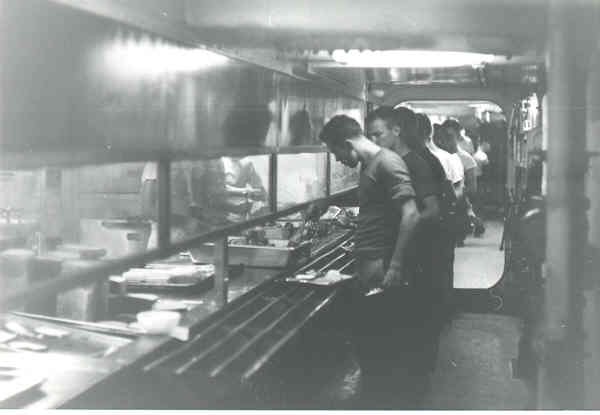 To
wait in the chow line that goes on forever
is miserable, but when you are doing it with no knowledge of what is at
the end of the wait, fasting is an option. The solution is to put
on your flight suit and pretend you are on flight status, which gets you
to the head of the line. The line bends and winds so many places
through the ship; all the crews can jump to the head of the line without
those behind getting suspicious. We notice that the flight suit draws
a lot of derogatory comments when worn throughout the ship. Guys
are pulling out money at the chow line trying to bribe the servers for
larger portions or an extra piece. The supply personnel go from ship
to ship bartering for raw materials to make our next mystery meal.
You hear them call up from the small launches, “we'll trade you 3 bags
of flour for 2 bags of sugar. Everyone is losing weight. I
am down to 145 lbs., which is a 15-20 lb loss. The negative aspect
of being next to where the garbage is ground up is becoming asset. After
each meal, the spoils of the kitchen are hauled up to our living area in
GI cans. It becomes a test of taste on how many layers of pancakes
are pealed off the top of the breakfast can to eat. No one knows
how many layers from bottom soak up the really bad stuff below them.
It is decided that if you can pick it up without it coming apart in your
fingers, it is good enough to eat. A sliver of peach in the bottom
of a tin can is like finding a gold nugget.
To
wait in the chow line that goes on forever
is miserable, but when you are doing it with no knowledge of what is at
the end of the wait, fasting is an option. The solution is to put
on your flight suit and pretend you are on flight status, which gets you
to the head of the line. The line bends and winds so many places
through the ship; all the crews can jump to the head of the line without
those behind getting suspicious. We notice that the flight suit draws
a lot of derogatory comments when worn throughout the ship. Guys
are pulling out money at the chow line trying to bribe the servers for
larger portions or an extra piece. The supply personnel go from ship
to ship bartering for raw materials to make our next mystery meal.
You hear them call up from the small launches, “we'll trade you 3 bags
of flour for 2 bags of sugar. Everyone is losing weight. I
am down to 145 lbs., which is a 15-20 lb loss. The negative aspect
of being next to where the garbage is ground up is becoming asset. After
each meal, the spoils of the kitchen are hauled up to our living area in
GI cans. It becomes a test of taste on how many layers of pancakes
are pealed off the top of the breakfast can to eat. No one knows
how many layers from bottom soak up the really bad stuff below them.
It is decided that if you can pick it up without it coming apart in your
fingers, it is good enough to eat. A sliver of peach in the bottom
of a tin can is like finding a gold nugget.
Our planes always need to have corrosion removed and we use high-pressure sprayers to wash the salt off. We replace water volume for pressure to get the job done. Fresh water is saved for the most critical jobs and functions. Most of the time we use waterless cleaner to conserve water and leave a light coating of oil on top of the wax. We do get distilled water to drink, but the showers are saltwater. They feel so good when you are taking it, but pretty itchy when the salt dries on your skin. Being a “salt” is not as neat as we thought as a recruit. We had watched the sailors take their blue jeans tied to a rope and drag along in the sea to give them the salty look on earlier cruises. We now know all this does is allowing you to buy utilities at a greater frequency. We have learned you earn the rank of “salt” through what you have done in the service and it does not come from a covering. We wish we weren't so salty.
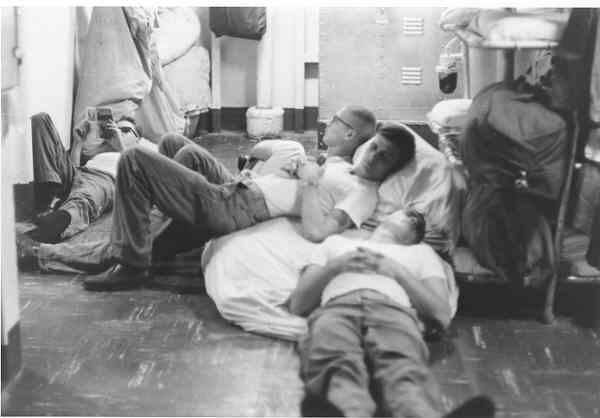 All
our dirty clothes are sent to the ship's laundry in large squadron bags.
Getting the clean clothes back is a big day
in the squad bay, but like everything else aboard ship, a little more difficult.
It wasn't long ago that we had house boys that picked up, washed, pressed,
and delivered at the foot of your beds the laundry of the day before. (See
I Remember, 1964, Warren Smith, 3-24-00, Skive Call)
All
our dirty clothes are sent to the ship's laundry in large squadron bags.
Getting the clean clothes back is a big day
in the squad bay, but like everything else aboard ship, a little more difficult.
It wasn't long ago that we had house boys that picked up, washed, pressed,
and delivered at the foot of your beds the laundry of the day before. (See
I Remember, 1964, Warren Smith, 3-24-00, Skive Call)
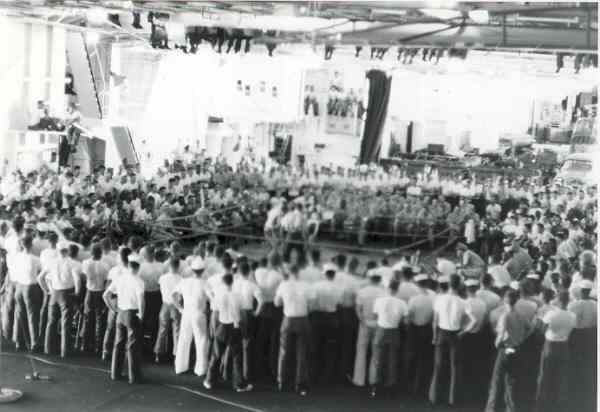 Money
loses its value and card games draw some unbelievable pots. Tempers
are starting to flare and minor irritants draw up the fists. Saturday
night “smokers” are run on the hanger deck to settle the arguments
in a more civil setting without doing a lot of damage. Grudges between
groups and service branches are also settled. It is fun to watch
the “haymaker” thrown in a rising sea and both combatants fall to the deck.
Those that learn the rhythm of the ship can use that momentum to floor
an opponent. It is fun to watch these warriors train with the weights
as they prepare for their Saturday night battles. Laying on your
back bench pressing a heavy lift can get out of control and dangerous on
a rolling ship. It is best to always have some assistance next to
each end of the weight.
Money
loses its value and card games draw some unbelievable pots. Tempers
are starting to flare and minor irritants draw up the fists. Saturday
night “smokers” are run on the hanger deck to settle the arguments
in a more civil setting without doing a lot of damage. Grudges between
groups and service branches are also settled. It is fun to watch
the “haymaker” thrown in a rising sea and both combatants fall to the deck.
Those that learn the rhythm of the ship can use that momentum to floor
an opponent. It is fun to watch these warriors train with the weights
as they prepare for their Saturday night battles. Laying on your
back bench pressing a heavy lift can get out of control and dangerous on
a rolling ship. It is best to always have some assistance next to
each end of the weight.
Reading helps pass the time, but paperbacks are at a premium. Few thought we would be at sea this long to be prepared with these ”boredom breakers”.
We all need some activity with a goal or end in sight.
August 31st.
It's
a wonderful day as we are resupplied with food
and mail. Everyone volunteers out of boredom and to get the important
raw materials to the cooks. Human conveyor lines are set up throughout
the hanger deck, down the ladders, and corridors 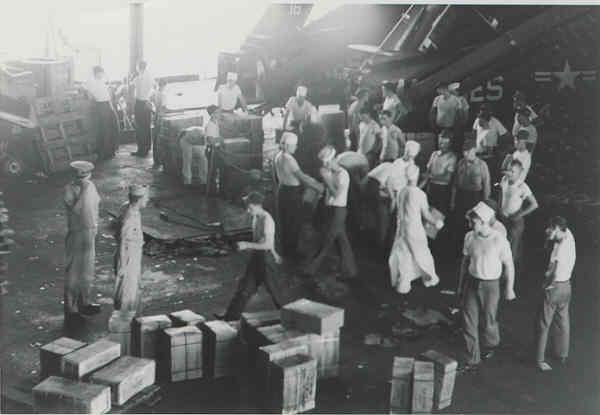 to the reefers and storage
decks below. 29 cases of frozen strawberries head down the line to
the reefer deck and only 3 make it to the end. All along the line
there are guys that look like they have lipstick on. I see a guy
really enjoying himself eating a pound of butter. A rule on deck
is that broken cases are shared with these volunteer stevedores. Guys raise
cases of oranges above their heads and smash them to the deck. The
human line evaporates as all run for these juicy delights. They fill
their pockets with as many as they can only to squash them as they pass
nondescript crates and boxes down the line. Smiles are starting
to return to the faces of the troops. Tomorrow will be a better day.
A loud cheer goes up as some SP’s chase someone racing to a hiding place
with a box of food. Everyone seems to have a hiding place and they
are full of food. Security is searching without a lot of enthusiasm
and everyone is thinking, “I won't be hungry again”. The cooks work
their butts off to turn this new raw material into something special.
We now have full stomachs and a letter to read. Life has taken a
turn toward the good.
to the reefers and storage
decks below. 29 cases of frozen strawberries head down the line to
the reefer deck and only 3 make it to the end. All along the line
there are guys that look like they have lipstick on. I see a guy
really enjoying himself eating a pound of butter. A rule on deck
is that broken cases are shared with these volunteer stevedores. Guys raise
cases of oranges above their heads and smash them to the deck. The
human line evaporates as all run for these juicy delights. They fill
their pockets with as many as they can only to squash them as they pass
nondescript crates and boxes down the line. Smiles are starting
to return to the faces of the troops. Tomorrow will be a better day.
A loud cheer goes up as some SP’s chase someone racing to a hiding place
with a box of food. Everyone seems to have a hiding place and they
are full of food. Security is searching without a lot of enthusiasm
and everyone is thinking, “I won't be hungry again”. The cooks work
their butts off to turn this new raw material into something special.
We now have full stomachs and a letter to read. Life has taken a
turn toward the good.
September 1st.
A new month stars, but the same old activity.
We are up at 0500 to spread the blades on the planes and fold them back
up at 1800 hours. We are on stand by all day, so there are no flights.
We want to conserve all the planes for maximum launch if needed.
September 3rd.
We receive some more mail. The supply system
is finally starting to catch up to us. I am happy with the 3 letters
I get. Letters get read over and over till the next arrive.
September 4th.
Another no fly day filled with the regular corrosion
fighting activity. The planes are starting to look a little strange.
We have plenty of the yellow green zinc chromate primer, but no olive drab
green topcoat. We never had any to start the tour and haven't received
any with the supply orders. I thought olive drab paint in the military
had the highest of priorities. The big military machine could not
move forward unless it was painted green. The guys are getting creative
with the primer adding some here and there to give personality to the corrosion
battle. We sure look rag tag. I hope the next squadron appreciates
our efforts and continues where we left off. The smelly planes in
Da Nang don't seem so bad now.
The 1st Sgt. is brought before a review board for inappropriate activities and relieved of duties.
September 5th.
We take on oil and gasoline in the afternoon.
We are fueling more support ships around us and so see the tanker on a
more frequent basis. A wooden hull minesweeper comes out from the
Mekong River to take on some JP-4 for their diesel engines. They
keep the shipping lanes clear from the coast to Saigon. Later, we
find out this caused quite a stink, because while we were filling up the
minesweeper, a Marine fighter squadron was down in Japan due to lack of
JP-4. Maybe they have some olive drab paint to trade for the JP-4.
September 6 – 30th.
Begins a period lost to boredom. We cruise up
and down the coast while the various governments play politics. There
seems to be a tormentor in flight control. We move the planes fore
and aft for no reason except to exercise the elevators. One day I
move on the flight deck fore to aft, down the elevator to the forward hanger
deck, to the rear or the hanger deck, back up the elevator to number 2
spot only to be repositioned aft for the night. Each stop requires
placement of at least 4 chains. There seems to be a mixture of movement
to and from an active launch spot requiring the spreading of the blades.
We don't need the practice, but it keeps us busy. I keep extra taper
pins in the plane. Occasionally, when you rap it to remove, it pops
out through your hand and over the side of the ship. I am glad I
am a crew chief and not a plane pusher. I get to ride the brakes,
but feel vulnerable on the outside elevators. In heavy seas, 6-8
chains are required. If you are walking a watch on the flight or
hanger deck you always are checking chains that are loose. If a strut
is losing pressure or fluid it will lower the plane and loosen the chain.
When the seas get heavy this is not a fun job. All doors and opening
are closed on the hanger deck with the planes as tight as you can get them.
They are leaking and venting gas fumes. With this mixture to breathe
and the rolling ship your stomach wants to empty its contents. A full stomach
of soda crackers is the best defense. Concentration on the chain
tensioning takes the mind away from talking to your stomach.
One day I had the opportunity for a flight to Saigon.
I have been trying to cash in a stack of US Savings Bonds to pay for a
Triumph TR-4 I purchased from Cars International in Okinawa. We have
taken a load of frozen steaks from the ship for the PX in Saigon.
From Da Nang, we hauled live meat on the hoof and from the ship we are
now hauling frozen steaks prepared in the States. We are making a
trade for equipment to pass time aboard ship. Radios, cameras, and
tape decks are hot items. I buy a Sony 500 reel to reel for $154
at the PX to beat the rush aboard ship. The PX won't cash my bonds
and I am dispatched to the Embassy. I walk in their front door and
sitting behind a desk in the middle of the floor is Cpl. Viola. Cpl.
Viola and I bunked in the same cube when serving together in 462.
He looks precarious sitting there until he invites me behind the desk.
He is armed with a .45 and has a riot gun and a Thompson in slots where
the drawers used to be. He said that various groups would come just
out front and taunt them to do something. He had seen beatings and
burnings and had to just sit there.
We relate our recent experiences to each other and
concede the life we had in Santa Ana was pretty tame. He said the
Marine activities in Da Nang are well noted at the Embassy. We go
to their barracks and have a few cold beers at their in-house bar.
In their day room, I notice a library that is full of paperbacks.
Paperbacks are prized possessions aboard ship to pass the time. When
I ask if we can borrow some, they strip the whole wall, box them and transport
all of it to the flight line for us. It is like Christmas back at
the ship with things to buy and read. Paperbacks are read in a unique way
to spread the wealth. As a chapter is read, it is ripped from the
book and passed to the next reader. There can be 6-10 people reading
the same book at the same time. I don't know if there was ever an
end where they were put back together or they just wore out. We are
extremely grateful to our fellow Embassy Marines and start to understand
more how the Corps has been strong for so long. We got the same support
from Embassy Marines when needed in Bangkok. Without question, they
dug into their own pockets to give us what they had. We had high
respect, as within the Corps, few Marines were in a combat role.
During this time, I just about cut Larry Haupert’s little finger off. The guys were throwing a ring of braided rope around in a game of keep away. I was sitting on the sidelines honing my survival knife on my boot when the overthrown ring kept dropping down next to me. One time when this happened, I grabbed it and cut the ring with my knife. Unfortunately, the knife went through the ring just as Larry was reaching for it. The knife was sharp enough to shave with and Larry never even felt it slide through his little finger. He reached down to see how deep the cut was and immediately could see bone. His face went white as the red blood rushed from the fingertip. He asked what we should do and I suggested we should go to sickbay. The navy doctor looked it and asked how it happened. We explained and all he said as he shook his head was “Marines”. He did say that at least you guys keep your knives sharp making my job easier. A few cat gut knots later and Larry was good as new.
September 30th.
We pull into Subic Bay and the night is spent at the
Sky Club. We get pretty smashed up and are lucky to find our way
home.
October 1st.
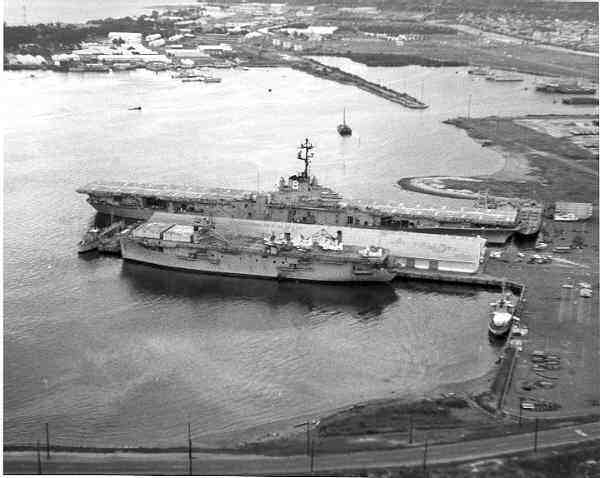 We
find ourselves coming and going from this our current dockage. Tied up
next to us on the same pier is the USNS Breton
on her way to Saigon with more A-1Es. We sailed from Long Beach to
Okinawa on the Breton to start our tour. Now, with the tour coming
to a close we meet again. I sure hope we don't have to make the return
trip to the States on her.
We
find ourselves coming and going from this our current dockage. Tied up
next to us on the same pier is the USNS Breton
on her way to Saigon with more A-1Es. We sailed from Long Beach to
Okinawa on the Breton to start our tour. Now, with the tour coming
to a close we meet again. I sure hope we don't have to make the return
trip to the States on her.
All the planes go to the seaplane landing. My
plane has just come out of check and has to stay aboard to preoil.
Had duty today, but was able to go to the PX at Subic, which is close to
the ship.
October 2nd.
Every thing checks out and we fly the plane to the
seaplane landing. We fly to Clark AFB which is a large base with
an interesting variety of aircraft. We actually see some old B-17s.
I try to cash my Savings Bonds, but get there to late. I am beginning
to wonder if I will ever be able to convert these savings and I want to
make sure my TR-4 is shipped from England on time. Larry Haupert
and I plan to drive it home following our discharge. I go to the
library for a quiet evening.
October 3rd.
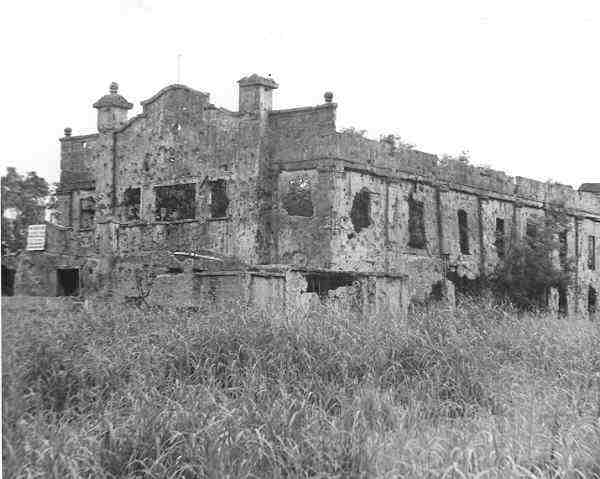 We
take a couple of planes to Corrigidor. We are given a tip that if
we take a few cans of mo-gas and give it to the Filipino soldiers, they
will drive us around the island. The tip is correct and we are given
a wonderful tour. Most of the original guns are still in place and
the buildings are riddled with battle scars. The masonry walls still
stand as stark skeletons of a terrible battle.
There is not a square foot that hasn't been hit with a direct round or
shrapnel. The Jap artillery had the whole island zeroed in and there
was no escape. We tour the underground tunnel where the President
of the Philippines family, McArthur, nurses and the wounded are kept safe
from the bombardment. The nurse's door had bars on it like a prison.
There is a club on the island that served cool drinks and you can send
a postcard. We get back in time to hit Subic for a T-bone and a flick.
It sure is nice to have choppers to see the countries where we are stationed.
Another
page of Corrigidor photographs.
We
take a couple of planes to Corrigidor. We are given a tip that if
we take a few cans of mo-gas and give it to the Filipino soldiers, they
will drive us around the island. The tip is correct and we are given
a wonderful tour. Most of the original guns are still in place and
the buildings are riddled with battle scars. The masonry walls still
stand as stark skeletons of a terrible battle.
There is not a square foot that hasn't been hit with a direct round or
shrapnel. The Jap artillery had the whole island zeroed in and there
was no escape. We tour the underground tunnel where the President
of the Philippines family, McArthur, nurses and the wounded are kept safe
from the bombardment. The nurse's door had bars on it like a prison.
There is a club on the island that served cool drinks and you can send
a postcard. We get back in time to hit Subic for a T-bone and a flick.
It sure is nice to have choppers to see the countries where we are stationed.
Another
page of Corrigidor photographs.
October 4th.
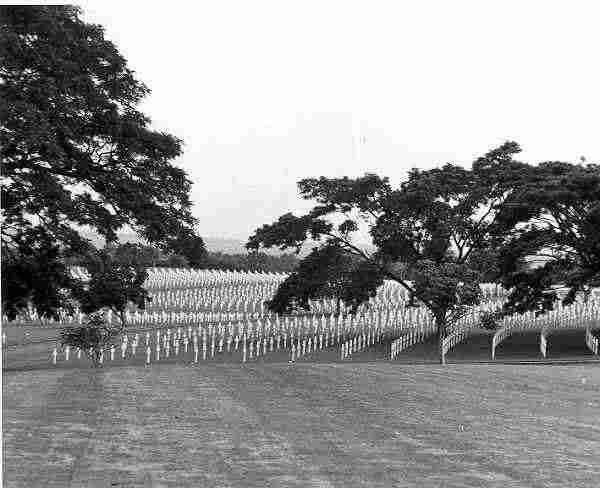 We
take a trip to Manila. A number of our squadron go on a bus tour
to the capital. We go to the National Cemetery
for the W.W.II dead, which is modeled after Arlington. There
is a separate section for each state and each major battle is done in mosaic.
We go to the President's palace which really the Philippine White House.
There is a section of the Manila suburb that is called Hollywood and looks
just like stateside with modern ranch houses, city streets, sidewalks and
large green lawns. You actually get a little home sick being there.
We visit a few prisons where the Japanese slaughtered quite a few Philippine
citizens and US troops because of neglect and brutality. We see the
source of the Japanese hatred that still exists in these islands.
We are allowed to head out on our own, which is pretty easy with most everyone
speaking English. We find a really good out of the way Chinese restaurant
with the direction of a some nice Filipino girls. When we get back
at 2330, all the ships in the harbor are gone including ours. We
hitch a ride to Cubic Pt and stay in our temporary barracks for the night.
We
take a trip to Manila. A number of our squadron go on a bus tour
to the capital. We go to the National Cemetery
for the W.W.II dead, which is modeled after Arlington. There
is a separate section for each state and each major battle is done in mosaic.
We go to the President's palace which really the Philippine White House.
There is a section of the Manila suburb that is called Hollywood and looks
just like stateside with modern ranch houses, city streets, sidewalks and
large green lawns. You actually get a little home sick being there.
We visit a few prisons where the Japanese slaughtered quite a few Philippine
citizens and US troops because of neglect and brutality. We see the
source of the Japanese hatred that still exists in these islands.
We are allowed to head out on our own, which is pretty easy with most everyone
speaking English. We find a really good out of the way Chinese restaurant
with the direction of a some nice Filipino girls. When we get back
at 2330, all the ships in the harbor are gone including ours. We
hitch a ride to Cubic Pt and stay in our temporary barracks for the night.
October 5th.
We had a great breakfast at the mess hall and then
flew out to the ship as they pulled back into Subic. Liberty was
called, but I had duty. There was a riot at the fleet landing with
all the guys getting back at the same time to return to their ships.
Everyone was drunk and a number of guys were getting pushed into the water
as the crowd surged forward with every returning boat. The boat had
to stop to rescue them. Many saw them getting in the boats ahead
of them and jumped in to be rescued also. It was getting dangerous
and out of control when they broke out the Marine Riot Squad with fixed
bayonets. All of a sudden there was some respect and order was restored.
It took till 0400 to get all back to their ship, a number with some good
size bumps on their heads.
October 6th.
We pulled out of port again heading west.
Oct 7th.
We are still sailing west toward our familiar work
area this year, Vietnam.
Oct 8th.
We finally join up with the task force off the coast
of Vietnam. We start PT on the flight deck with Lt Bland. We
are suppose to be getting in shape for the H and M when we return to Okinawa.
The sailors love watching us and are glad no one expects them to be in
shape gladiators. Doing exercise on the flight deck in Southeast
Asia is hot work to start the day when the relief is saltwater showers.
October 9th.
The plane is moved to the flight deck and we have
PT again. Pushing these planes around, chaining them down, climbing
up to the rotor head and spreading the blades seems like exercise to me.
I guess if it is not organized, it doesn’t do you any good. I don’t
see any problem passing my physical endurance test. I sleep most
of the day to pass the time as the plane isn’t moved and there is a decent
breeze. I help Powers field day the S-1 office. I have been
spending time there in the evening practicing my typing and taping music
on my new tape recorder. We really break a sweat cleaning, but the
place is super squared away. The place looks better than when they
moved in.
October 10th.
Our plane is brought down to the hanger deck for an
engine change. We switch with YK-16 because ours has over 600 hours
and YK-16 is going to Overhaul and Repair soon. We got both engines
hung after a lot of plane moving to get them close to each other.
October 11th.
We hooked up the engine and rigged the throttle.
We worked till 2000 getting ready for a test tomorrow. Stayed up
till 0400 taping music.
October 12th.
I was up at 0600 for flight quarters and finished
up work on the plane including pre-oiling. We test hop and the plane
takes off like it had an afterburner compared to the old engine.
Stayed up till 0230 listening to tapes. My days and nights are getting
turned around with all the waiting for something to happen. I send
$75 to Cars International letting them know I will send more when I can
get my savings bonds cashed. I also get a letter off to Pat.
October 13th.
We get word we are headed back to port for the last
time.
October 14th.
We are headed for Subic.
October 15th.
We get the planes ready for tomorrow's launch.
The navy is having an efficiency inspection tomorrow also. I pack
up my gear and move it into plane. All areas have to be squared away
for the inspection and our leaving.
October 16th.
Today is my 22nd birthday. A lot has been crammed
into this year since the last birthday. I feel a lot older than I
have in the past. My tour of duty is coming to an end and I will
not spend another birthday in the Corps. We are up at 0330, launch
at 0630, landing at Cubi is done and secured by 1100, and the ship docks
at Subic at 1400. I go to the Subic PX and eat 2 banana splits to
celebrate my birthday. The waitress can't believe it when I order
the second one. You really craved ice cream aboard ship when we didn't
even have milk. Cpl. Weber and I go to town and hit a few bars, but
come back early. Maybe we are getting smarter.
October 17th – 20th.
We stay on the base at Cubi waiting for the C-130
to pick us up and return to Okinawa. This cruise has not been what
it was advertised. The hours and days dragged on, it was hot and
disagreeable, we ran out of food, and the big fight was always just out
to the front of us. We spent pretty much all our time cruising the
coast of Vietnam instead of hitting all the exotic ports of this part of
the world. It will be good to get back to Okinawa with good facilities
and a known schedule.
Submitted by:
Warren R. Smith, former Cpl. USMC